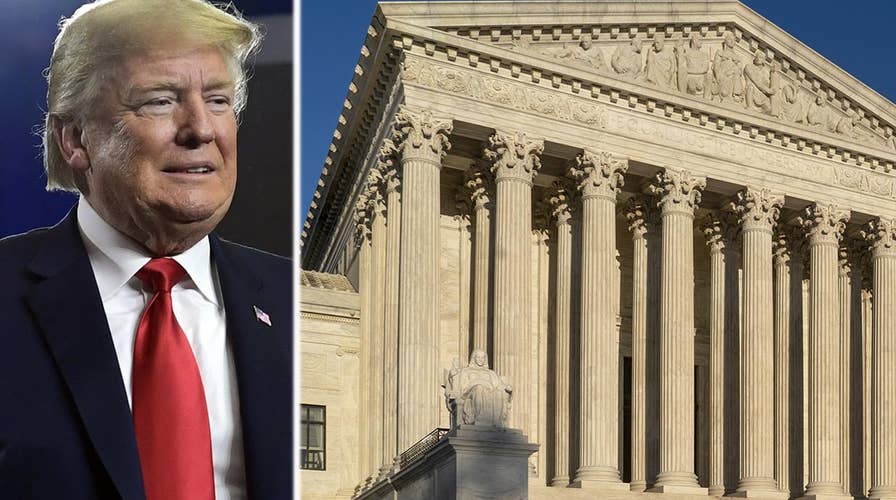Trump calls Supreme Court decision 'a tremendous victory'
President Trump praises the Supreme Court's decision on his travel ban; chief White House correspondent John Roberts reports from Washington.
The Supreme Court decision Tuesday upholding President Trump’s “travel ban” also sent a subtle but clear message to lower federal court judges – don’t get too big for your britches. This was reinforced by Justice Clarence Thomas's warning to judges who attempt to set national policy by issuing overly broad orders.
The 17-month legal battle over the "travel ban" ended Tuesday with a 5-4 victory for the president in the Supreme Court and a setback for those who have tried to portray the president's immigration policies as discriminatory.
Ruling in Trump v. Hawaii, the high court upheld the travel ban in its entirety, reversing lower courts that had seemed to join the Trump Resistance.
President Trump's travel ban, aimed at countries that failed to provide the information necessary to properly vet travelers to the U.S., was twice revised to satisfy judges who second-guessed the president's statutory authority and concluded that the ban was intended to discriminate against Muslims. The third and final version of the ban, upheld Tuesday, limits travel from seven countries: North Korea, Venezuela, Iran, Syria, Libya, Somalia and Yemen.
In the age of judicial activism, making policy has become very tempting for certain judges. The result is to politicize the judiciary and erode the vital principle of an impartial judiciary.
Writing for the majority, Chief Justice John Roberts found that the relevant statute "vests the President with ample power" to enact the ban. Moreover, the list of nations included in the ban "does not support an inference of religious hostility, given that the policy covers just 8 percent of the world’s Muslim population and is limited to countries that were previously designated by Congress or prior administrations as posing national security risks."
Also before the court was the question of whether the district court below exceeded its authority by issuing a court order with universal scope, covering all affected foreigners regardless of whether they had any connection to the plaintiffs – the state of Hawaii, the Muslim Association of Hawaii, and three people whose foreign relatives were affected by the ban. Roberts noted that, because the ban was upheld, it was "unnecessary to consider the propriety of the nationwide scope of the injunction."
Nonetheless, Thomas wrote a separate concurring opinion to address the issue of universal injunctions – also called "nationwide" or "national" injunctions – which by definition prohibit the enforcement of a federal law against everyone, rather than just the plaintiffs before the court. Thomas noted that such court orders "have exploded in popularity" recently and "are legally and historically dubious."
The frequency of universal injunctions, which were unknown before the middle of the 20th century, increased markedly in President Obama's second term, as states and individuals went to court to challenge the executive overreach born of his “pen-and-phone” strategy.
A further increase has occurred since President Trump's election, with universal injunctions providing an important tool for federal judges whose anti-Trump opinions make one wonder if they've joined the Resistance.
In addition to the travel ban litigation, a notable example is the San Francisco U.S. District Court judge who used of a local case to issue a nationwide injunction against President Trump's order ending the Deferred Action for Childhood Arrivals program (DACA).
This is not to say that universal injunctions are never appropriate. Occasionally an injunction needs to be nationwide to afford full relief to the specific plaintiffs in a case. But as a general rule, such court orders pose a real danger to the legal system, the separation of powers and democratic principles.
As Thomas pointed out, these "injunctions are beginning to take a toll on the federal court system – preventing legal questions from percolating through the federal courts, encouraging forum shopping, and making every case a national emergency for the courts and for the Executive Branch."
Universal injunctions are also undemocratic, allowing a single unelected U.S. District Court judge to set policy for the entire nation.
"For most of our history, courts understood judicial power as fundamentally the power to render judgments in individual cases. They did not believe that courts could make federal policy," Justice Thomas said in his concurring opinion.
In the age of judicial activism, making policy has become very tempting for certain judges. Adding to the heady feeling is the ability of a single district judge to use a universal injunction to effectively trump all the other district courts considering challenges to the same federal law. The result is to politicize the judiciary and erode the vital principle of an impartial judiciary.
Even the Founding Fathers recognized the danger of judges expanding their role beyond granting relief to the parties before them, as Justice Thomas reminded us: "Misuses of judicial power, [Alexander] Hamilton reassured the people of New York, could not threaten 'the general liberty of the people' because courts, at most, adjudicate the rights of 'individual[s].'"
By reminding lower court judges that the Constitution gave them limited powers, Tuesday's Supreme Court decision and particularly Justice Thomas's concurrence, may slow the pace of national injunctions a bit. But power is as intoxicating for lower court judges as for anyone else, and being part of the Resistance is very fashionable in San Francisco, Hawaii and the like.
Justice Thomas recognized that the problem of universal injunctions is not going away when he said: "If their popularity continues, this Court must address their legality." A solution might also come from Congress, which could enact a law setting limits on the practice.
While the Supreme Court's travel ban decision increases the cries of those who believe President Trump is a threat to democracy, the real threat to democracy posed by universal injunctions awaits a solution.





















